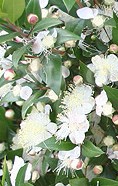 Common myrtle (Myrtus communis) is an evergreen shrub native to the Mediterranean area. It grows up to fifteen feet high but takes well to shearing and so is often kept smaller and used as a hedge. The dark green leaves are fragrant and one to three inches long. The fragrant flowers appear during the summer and have five white or pink petals around a large number of stamens that create a soft fuzzy look. Plants like full sun and moist, well-drained soil. They are hardy in USDA zones 8-9.
Common myrtle (Myrtus communis) is an evergreen shrub native to the Mediterranean area. It grows up to fifteen feet high but takes well to shearing and so is often kept smaller and used as a hedge. The dark green leaves are fragrant and one to three inches long. The fragrant flowers appear during the summer and have five white or pink petals around a large number of stamens that create a soft fuzzy look. Plants like full sun and moist, well-drained soil. They are hardy in USDA zones 8-9.
Shakespeare mentions myrtle in four different works,
1. In Antony and Cleopatra (act iii, sc. 12, 8) Euphronius, as an ambassador of Antony, says to Octavius Caesar;
I was of late as petty to his ends
As is the morn-dew on the Myrtle-leaf
To his grand sea.
2. Isabella, in Measure for Measure (act ii, sc. 2, 114), says as she pleads with Angelo to spare her brother;
Merciful Heaven,
Thou rather with thy sharp and suphurous bolt
Split’st the unwedgeable and gnarled Oak
Than the soft Myrtle.
3. Passionate Pilgrim, 143
Venus, with young Adonis sitting by her,
Under a Myrtle shade began to woo him.
4. Venus and Adonis, 865
Then sad she hasteth to a Myrtle grove
From ancient times myrtle was associated with love. In Greek mythology myrtle was associated with Aphrodite as well as Demeter and the Roman associated the plant with Venus. Women wore crowns of myrtle when they bathed during the Veneralia , a festival in honor of Venus and myrtle played a role in weddings, a custom still practiced in England. Myrtle was introduced into England in 1585 by Sir Walter Raleigh and Sir Francis Carey. The botanist John Gerard, contemporary of Shakespeare, mentions six different varieties of myrtle that grew in England, probably only in the warmer parts of the country since myrtle is not very hardy. The wood of the plant is fine grained, considered very strong andis used for such things as tool handles, walking sticks, and furniture. Interesting that Shakespeare speaks of “soft myrtle” in contrast to “the unwedgeable and gnarled Oak” (quote 2 above).